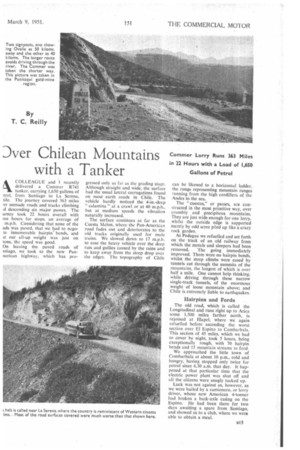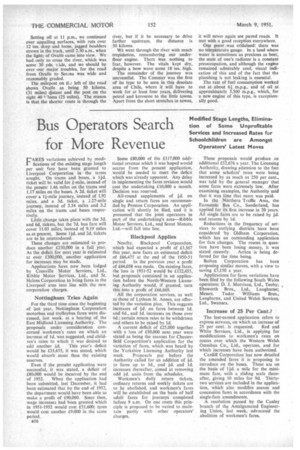Dyer Chilean Mountains with a Tanker
Page 49

Page 50

If you've noticed an error in this article please click here to report it so we can fix it.
By T. C. Reilly kCOLLEAGUE and I recently delivered a Commer R74I tanker, carrying 1,650 gallons of .trol, from Santiago to La Serena, lite. The journey covered 363 miles ,er unmade roads and tracks climbing d descending six major passes. The urney took 22 hours overall with tee hours for stops, an average of m.p.h. Considering that none of the ads was paved, that we had to negote innumerable hairpin bends, and at our all-up weight was just on tons, the speed was good.
On leaving the paved roads of ntiago, we took to the new Pannerican highway. which has pro gressed only as far as the grading stage. Although straight and wide, the surface had the usual lateral corrugations found on most earth roads in Chile. The vehicle hardly noticed the 4-in.-deep " Qtlamina " at a crawl or at 40 m.p.h., but at medium speeds the vibration naturally increased.
The surface continues as far as the Cuesta Melon, where the Pan-American road fades out and deteriorates to the old tracks originally used for mule trains. We slowed down to 17 m.p.h. to ease the heavy vehicle over the deep ruts and gullies caused by the rains and to keep away from the steep drop over the edges. The topography of Chile can be likened to a horizontal ladder, the rungs representing mountain ranges running from the high cordillera of the Andes to the sea.
The " cuestas," or passes, are constructed in the most primitive way, over crumbly and precipitous mountains. They are just wide enough for one lorry, whilst the outside edge is supported merely by odd scree piled up like a crazy rock garden.
At Pedagua we refuelled and set forth on the track of an old railway from which the metals and sleepers had been removed. The going immediately improved. There were no hairpin bends, whilst the steep climbs were eased by tunnels cut through the summits of the mountains, the longest of which is over half a mile. One cannot help thinking, while driving through these narrow single-track tunnels, of the enormous weight of loose mountain above; and Chile is extremely liable to earthquakes.
Hairpins and Fords
The old road, which is called the Longitudinal and runs right up to Arica some 1,500 miles farther north, is rejoined at Illapel, where we again refuelled before ascending the worst section over El Espino to Combarbala. This section of 45 miles, which we had to cover by night, took 5 hours, being exceptionally rough, with 70 hairpin bends and 15 mountain streams to ford.
We approached the little town of Combarbala at about 10 p.m., cold and hungry, having stopped only twice for petrol since 6.30 am, that day. It happened at that particular time that the electric power plant was shut off and all the citizens were snugly tucked up.
Luck was not against us, however, as we were hailed by a camionero, or lorry driver, whose new American 4-tonner had broken a back-axle casing on the Espino. He had been there for two days awaiting a spare from Santiago, and showed us to a club, where we were able to obtain a meal. Setting off at 11 p.m., we continued over appalling surfaces, with ruts over 12 ins, deep and loose, jagged boulders strewn in the track, until 2.30 a.m., when the lights of Ovalle came into view. We had only to cross the river, which was some 30 yds. LiJe, and we should be over .our major troubles, for the road from Ovalle to Serena was wide and reasonably graded.
The milepost on tic left of the road shows Ovalle as being 50 kiloms. (31 miles) (Patent and the post on the right 40 Vloms (25 miles). The reason is that the shorter route is through the river, but if it be necessary to drive farther upstream, the distance is 50 kiloms.
We went through the river with much trepidation, remembering our underfloor engine. There was nothing to fear, however. The vitals kept dry, despite a bow wave some 18 ins. high.
The remainder of the journey was uneventful. The Commer was the first ofits type to be seen in this desolate area of Chile, where it will have to work for at least four years, delivering petrol and kerosene to the tittle towns. Apart from the short stretches in towns,
it will never again see paved roads. It met with a good reception everywhere.
One point was criticized: there was no temperature gauge. In a land where water is sometimes as precious as beer, the state of one's radiator is a constant preoccupation, and although the engine remained admirably cool, visual indication of this and of the fact that the plumbing is not leaking is essential.
The rate of fuel consumption worked out at about 6/ m.p.g., and of oil at approximately 3,500 m.p.g., which, for a new engine of this type, is exceptionally good.




















































































